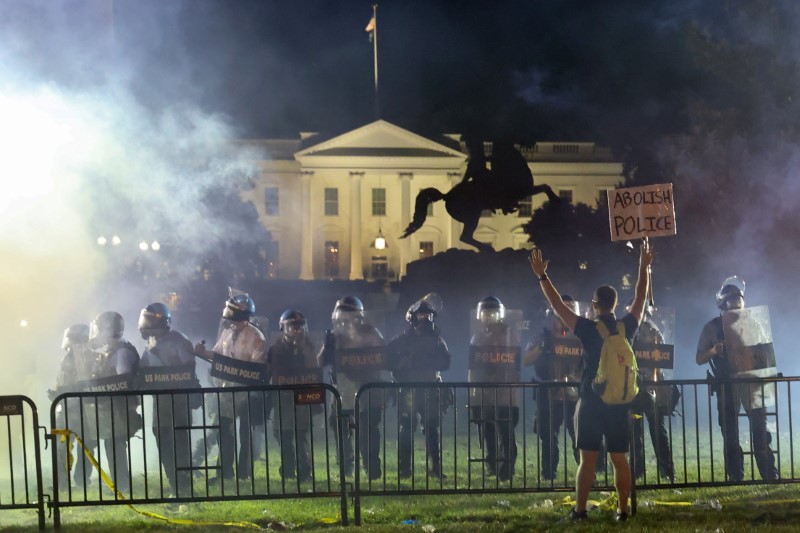
By Jonathan Ernst and Brendan O’Brien
WASHINGTON/MINNEAPOLIS (Reuters) – At least five U.S. police were hit by gunfire during violent protests over the death of a black man in police custody, police and media said, hours after President Donald Trump said he would deploy the military if unrest does not stop.
Trump deepened outrage on Monday by posing at a church clutching a bible after law enforcement officers used teargas and rubber bullets to clear the way for him to walk there after he made his remarks in the White House Rose Garden.
Demonstrators set fire to a strip mall in Los Angeles, looted stores in New York City and clashed with police in St Louis, Missouri, where four officers were taken to hospital with non-life-threatening injuries.
An emotional St Louis police commissioner, John Hayden, said about 200 protesters were “jumping up and down like crazy people”, looting and throwing fireworks and rocks at officers.
“We had to protect our headquarters building, they were throwing fireworks on officers, fireworks were exploding on officers,” he told reporters. “They had officers with gas poured on them. What is going on? How can this be? Mr Floyd was killed somewhere else and they are tearing up cities all across the country.”
A police officer was also shot during protests in the Las Vegas Strip area, AP news agency said, quoting police. Another officer was “involved in a shooting” in the same area, the agency said.
It gave no details of the shootings or the officers’ condition. Police declined to comment to Reuters.
Trump has condemned the killing of George Floyd, a 46-year-old African American who died after a white policeman pinned his neck under a knee for nearly nine minutes in Minneapolis on May 25, and has promised justice.
But, with anti-police brutality marches and rallies having turned violent after dark each day in the past week, he said rightful protests could not be drowned out by an “angry mob”.
“Mayors and governors must establish an overwhelming law enforcement presence until the violence has been quelled,” Trump said. “If a city or state refuses to take the actions that are necessary to defend the life and property of their residents, then I will deploy the United States military and quickly solve the problem for them.”
Floyd’s death has reignited simmering racial tensions in a politically divided country that has been hit hard by the coronavirus pandemic, with African Americans accounting for a disproportionately high number of cases.
CRITICISM OF CHURCH VISIT
After his address, Trump posed for pictures with his daughter, Ivanka, and U.S. Attorney General William Barr at St. John’s Episcopal Church near the White House.
The presiding bishop of the Episcopal Church diocese in Washington D. C., Michael Curry, was among those who criticized Trump’s use of the historic church for a photo opportunity.
“In so doing, he used a church building and the Holy Bible for partisan political purposes,” he said on Twitter. The church suffered minor fire damage during protests on Sunday night.
The White House said it was clearing the area before a curfew.
A few hours later, thousands of people marched through Brooklyn, shouting “Justice now!” while some passing drivers honked in support.
Television images showed crowds smashing windows and looting luxury stores along Fifth Avenue in Manhattan before the city’s 11 p.m. curfew. Mayor Bill de Blasio said the curfew would be moved to 8 p.m. on Tuesday.
Two police officers were struck by a car at a demonstration in Buffalo, New York, on Monday night. Officials said the driver and passengers were believed to be in custody. It was not clear whether the incident was intentional.
In Hollywood, dozens of people were shown in television images looting a drug store. Windows were shattered at a nearby Starbucks and two restaurants.
AUTOPSIES
A second autopsy ordered by Floyd’s family and released on Monday found his death was homicide by “mechanical asphyxiation,” or physical force that interfered with his oxygen supply. The report says three officers contributed to his death.
The Hennepin County Medical Examiner later released autopsy findings that also called Floyd’s death homicide by asphyxiation. The county report said Floyd suffered cardiopulmonary arrest while being restrained by police and that he had arteriosclerotic and hypertensive heart disease, fentanyl intoxication and recent methamphetamine use.
Derek Chauvin, the 44-year-old Minneapolis police officer who kneeled on Floyd, was arrested on third-degree murder and second-degree manslaughter charges. Three other officers involved in the arrest have not been charged.
Floyd’s death was the latest case of police brutality against black men that was caught on videotape and prompted an outcry over racism in U.S. law enforcement.
Dozens of cities are under curfews not seen since riots after the 1968 assassination of Martin Luther King Jr. The National Guard deployed in 23 states and Washington, D.C.
(Reporting by Aakriti Bhalla, Subrat Patnaik, Lisa Lambert, Andy Sullivan, Maria Caspani, Peter Szekely, Lucy Nicholson, David Shepardson, Michael Martina, Brendan O’Brien, Sharon Bernstein, Lisa Richwine and Dan Whitcomb; Writing by Dan Whitcomb and Nick Macfie; Editing by Cynthia Osterman, Lincoln Feast, and Timothy Heritage)
















